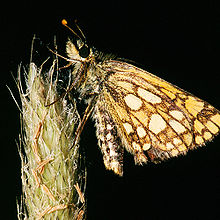Carterocephalus palaemon
| Chequered skipper | |
|---|---|
 |
|
 |
|
| Scientific classification | |
| Kingdom: | Animalia |
| Clade: | Euarthropoda |
| Class: | Insecta |
| Order: | Lepidoptera |
| Family: | Hesperiidae |
| Genus: | Carterocephalus |
| Species: | C. palaemon |
| Binomial name | |
|
Carterocephalus palaemon (Pallas, 1771) |
|
The chequered skipper (Carterocephalus palaemon), not to be confused with the large chequered skipper, is a small woodland butterfly in the family Hesperiidae. This butterfly can live in grasslands. The upperside of the butterfly is brown with orange spots and on its underside the chequered skipper is orange with brown spots. Chequered skippers are found throughout the United Kingdom and other European countries, but seen locally in Japan, Canada, and the United States. In North America the chequered skipper is known as the arctic skipper. The size of the chequered skipper ranges from 19 to 32 mm with females being larger. In the 1970s, the chequered skipper went extinct in England due to the new management of the woodlands.
This butterfly has a wingspan of 29 to 31 mm. The uppersides of chequered skippers are dark brown with orange scales at the base of the wings and golden spots, giving it its English name of chequered skipper. The basic pattern on the underside is similar but the forewings are orange with dark spots, and the hindwings are russet with cream spots rimmed in black. The sexes are similar although females are generally slightly larger.
The chequered skipper has been sighted in England, Ireland, Scotland, and Wales. Now, the chequered skipper is only seen in western Scotland. The butterfly has also reached parts of Japan but facing threats there. In the United States the chequered skipper is also known as the arctic skipper and is found in the northern coasts and expands to central Alaska. The chequered skipper can be seen in central California. The chequered skipper has been seen along the coasts of Canada. It is generally considered a woodland butterfly and breeds in and around damp woodland, favoring clearings and woodland paths and seems to have a particular attraction to blue woodland flowers.
The chequered skipper has been extinct in England since 1976 but has stable populations in western Scotland. Attempts to reintroduce the butterfly to England were started in the 1990s. It was previously widespread in the Midlands, with isolated populations as far south as Devon and Hampshire. It is thought that the cessation of coppicing in English woodlands is the main cause of its extinction. It was only discovered in Scotland in 1939 where it was found in grassland on the edges of open broad-leaved woodland. In May 2018, 50 individual chequered skippers are to be reintroduced to Rockingham Forest in Northamptonshire by Butterfly Conservation.
...
Wikipedia
